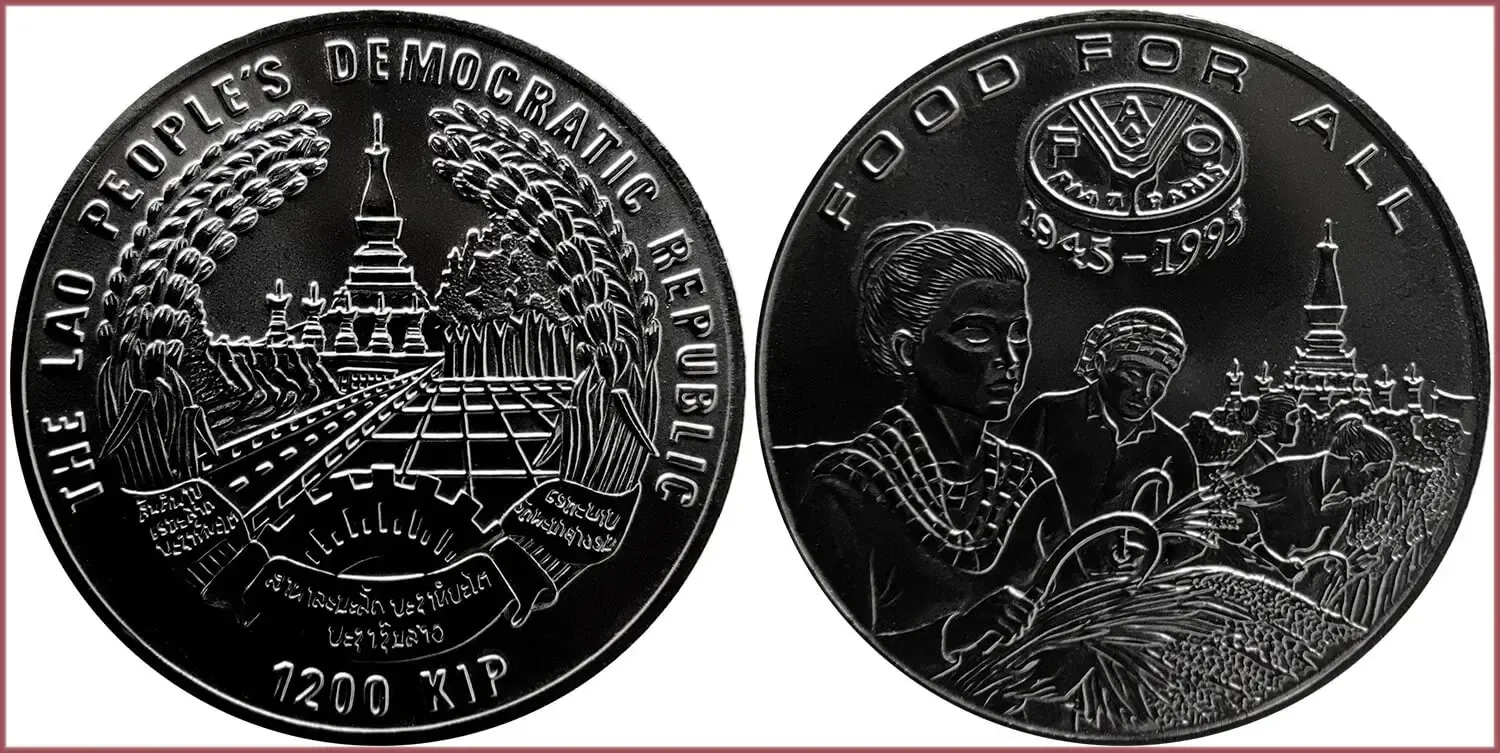KIP: COIN OF LAOS
1200 kip, 1995: Lao People's Democratic Republic
Commemorative coin: FAO series (F.A.O. — the Food and Agriculture Organization of the United Nations — specialized agency of the United Nations that leads international efforts to defeat hunger and improve nutrition and food security).
THE LAO PEOPLE'S DEMOCRATIC REPUBLIC.
1200 KIP.
The National Emblem of the Lao People's Democratic Republic: the national shrine Pha That Luang; a dam (symbol of power generation at the reservoir Nam Ngum); an asphalt street, as well as a stylized watered field (organic combination of agriculture and urban space in Laos). The inscriptions as national mottos "Peace, Independence, Democracy" (Lao "ສັນຕິພາບ ເອກະລາດ ປະຊາທິປະໄຕ") and "Unity and Prosperity" (Lao "ເອກະພາບ ວັດຖະນາຖາວອນ").
FOOD FOR ALL (motto).
Logo of the Food and Agriculture Organization with Latin motto "Fiat Panis" — "Let there be Bread".
1945-1995: the coin is dedicated to the 50th anniversary of the founding of the FAO.
People harvesting rice in front of a Pha That Luang Pagoda.
Mintage: 20.200.
- Nickel plated steel: 33 mm - 12.7 g
- Reference price: 8.1$
COIN KIP — WHERE & WHEN (coins catalog: by names & emitents)
- LAO PEOPLE'S DEMOCRATIC REPUBLIC (1971-...): kip = 100 att
KIP as coin name.
Kip (Lao "ກີບ") — unchanged monetary unit of Laos since 1955, divided into 100 att.
For a while, Laos was part of French Indochina, a former European colonial possession in Southeast Asia. In the post-war period, instead of the Indochinese piastre, the national currency, — kip — was introduced. At first, these were only banknotes and small exchange coins of the Kingdom of Laos. However, already in 1971, the first coins with a denomination expressed in kip appeared. These were silver and gold non-circulating coins (1000, 2500, 4000, 5000, 8000, 10000, 20000, 40000 and 80000 kip) with traces of the colonial past — the legend was in both Lao and French. By the way, unofficially, kips continued to be traditionally called piastres.
Shortly before the proclamation of the Lao People's Democratic Republic (1975), a new series of 1975 coins was issued — also non-circulating kip coins of the Kingdom of Laos.
In 1985, commemorative non-circulating coins of 1, 5, 10, 20 and 50 kip dedicated to the 10th Anniversary of the People's Democratic Republic were minted. They are extremely rare among collectors.
In the future, the issue of kip denomination coins became massive and regular. However, all of them were also commemorative and jubilee — not for circulation.
Along with the kip, the Thai baht and the US dollar are used equally in Laos.
If you trace the history of the kip coin, you can see a pattern: the first issues contained legends in Lao and French, then coins were minted with inscriptions only in Lao, and even later — in English (probably the reason for the positioning of later Lao coins as intended for foreign tourists and numismatists).
The name kip coin comes from the term "ກີບ" in the Lao language, which literally translates as "ingot". There is also ambiguous information that the related term "ກິບ" (the characters "ກີ" and "ກິ" are minimally different both in writing and in sound when pronounced) in the lands of modern Laos was used to call round money signs, i.e. coins (for example, the Spanish dollar common in the region) — in contrast to the silver ingots used by the local population. It is difficult for me to answer which of the mutually exclusive statements is more true...






